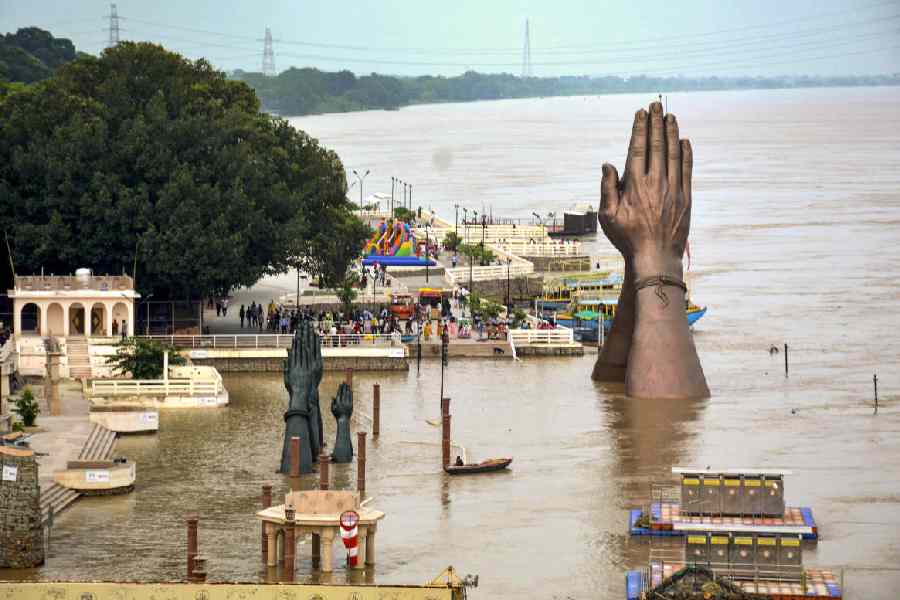Prime Minister Narendra Modi’s constituency Varanasi, which he claims to have turned into a “smart city”, has been swamped by floods with many temples along the Ganga having to shut their doors to devotees and a large number of residents living along the famed ghats relocated.
The situation has come to such a pass that bodies being brought to Manikarnika and Harishchandra Ghats are having to be cremated on the terraces of platforms that are part of Modi’s beautification project in Varanasi. The bodies are being brought in boats as the areas around the ghats are submerged in water.
All this despite the water level in the Ganga flowing 48cm below the danger mark. It was 70.78 metres on Tuesday and according to the bulletin of the Central Water Commission, the water level is increasing by 0.5cm per hour.
“Manikarnika Ghat, Harishchandra Ghat and many other areas are submerged in floodwaters. Water has entered Ram Nagar Quila, Sujabad and Domri. Maharishi Ved Vyas temple and many other shrines have been closed and barriers raised on the roads leading to them,” a local municipal official said.
“This problem (flood) always existed here to some extent but it is becoming worse because of the concrete constructions along the Ganga,” he added.
The central and Uttar Pradesh governments have together constructed platforms along the Ganga for the recreation of tourists. This includes the Namo Ghat, which was known earlier as the Khirkiya Ghat. The ghat was a kachchha structure before but huge concrete platforms that jut into the river have been built there two years ago.
Lord Shiva is addressed as Namo but there is a general perception that in this case, the reference is to the Prime Minister’s initials.
“The sewers are overflowing in Lanka, Ramsaheni Ghat, Saket Nagar, Batuapur and Kashipur because of the flood. A large number of residents have been shifted to other places,” the civic official said. “Floodwaters from the Varuna river have also entered Uchwa, Dhobi Ghat, Meera Ghat, Chauka Ghat, Dhelwariya and Shailputri. There are over a dozen ancient temples in these areas which have had to be closed to devotees.”
S. Rajalingam, the district magistrate of Varanasi, told reporters: “Around 4,461 people have been affected by the flood in Varanasi town.”
“We have deployed 22 boats to rescue the affected people. Water police are also on the job on their motorboats. There are 14 relief camps in the district where 229 families are living. We are taking care of those who are staying there,” the DM said.
Ajay Rai, a veteran journalist in Varanasi, said: “The areas on both sides of the Varuna river and Assi Nallah had become uninhabitable in 1978 when the city had witnessed its worst floods. At that time, there was no constructions in these areas. Later, the local development authority set up colonies in these places.
“Then there are some areas that have been encroached and houses built. The current dispensation has built additional permanent structures in these areas in recent years in the name of beautification of the city. Obviously, a little bit of a rise in the water level will play havoc in those areas of the city.”
Saurabh Singh, a river scientist, said: “Constructions in the streams of the river, dumping of construction materials in the river and renovation of the ghats in recent years without protecting the old sewer lines are some of the reasons behind the flood. The returning monsoon has added to the crisis.”
“According to our estimates, government agencies and private builders have dumped several hundred tonnes of debris in the Ganga in Varanasi in the last three years. Obviously, the capacity of the river to hold water has decreased and it is overflowing into the residential areas. Encroachment is so rampant that we shouldn’t be surprised if the river vanishes after a few decades and the whole of Varanasi is submerged even after minor rainfall,” he added.











